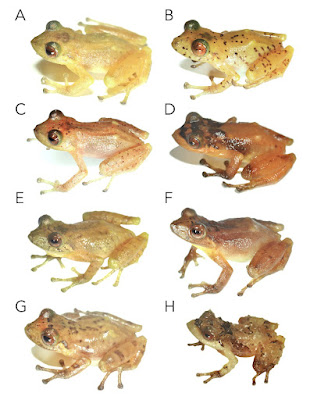 |
Pristimantis dorsopictus (Rivero & Serna, 1988) [A-H] Pristimantis cryptopictus Patiño-Ocampo, Duarte-Marín & Rivera Correa, 2022 Photos: M. Rivera Correa. twitter.com/biodiversitario |
Abstract
The phenotypic variation of some species at the geographic level makes them excellent models to evaluate different evolutionary attributes and answer questions related to their diversity. In addition, the constant effort of sampling in high Andean ecosystems that include the type localities of the species, and the integration of a novel data set can lead to unsuspected taxonomic findings. In this study we provide genetic, bioacoustics and morphological evidence to support the delimitation, and description of a new species from the northern Andean forests, historically confused with Pristimantis dorsopictus (Rivero & Serna, 1988). The latter and the new species were not recovered as sister lineages in our phylogenetic analyses, and although they are relatively similar, both differ phenotypically in body size, coloration pattern, skin texture, call duration and dominant frequency, among other attributes. Our phylogenetic inference suggests that the new species is part of the P. boulengeri group and was recovered as sister to the clade that includes P. urani, P. angustilineatus, P. boulengeri, P. brevifrons, and P. dorsopictus. The results suggest that advertisement calls constitute an important source of information for understanding the acoustic diversity of the P. boulengeri group and for delimiting the species of the genus Pristimantis, which despite its great diversity, presents a limited acoustic knowledge in those with distribution in Colombia.
Keywords: Andes, cryptic diversity, haplotype network, geography, phylogenetics.
 |
| Holotype of Pristimantis dorsopictus sp. nov. MHUA-A 12478, SVL 23.5 mm, adult male. Photos: Mauricio Rivera Correa. |
 |
| Pristimantis dorsopictus in life: (A) MHUA-A 12483, SVL 19.1 mm, adult male; (B) MHUA-A 12482, SVL 20.1 mm, adult male; (C) MHUA-A 12490, SVL 19.6 mm, adult male; (D) MHUA-A 12499, SVL 20.9 mm, adult male; (E) MHUA-A 12501, SVL 18.7 mm, adult male; (F) MHUA-A 12502, SVL 20.0 mm, adult male; (G) MHUA-A 12493, SVL 20.8 mm, adult male; MHUA-A 12494, SVL 30.8 mm, adult female; (H) MHUA-A 12503, SVL 10.1 mm, juvenile. Photos: Mauricio Rivera Correa. |
Pristimantis cryptopictus sp. nov.
Eliza Patiño-Ocampo, Sebastián Duarte-Marín and Mauricio Rivera Correa. 2022. GENÉTICA, BIOACÚSTICA Y MORFOLOGÍA REVELAN UNA NUEVA ESPECIE OCULTA EN Pristimantis dorsopictus (ANURA: STRABOMANTIDAE). [Genetics, Bioacoustics, and Morphology Reveal A New Hidden Species in Pristimantis dorsopictus (Anura: Strabomantidae)]. Revista Latinoamericana De Herpetología. 5(1), 60–90. DOI: 10.22201/fc.25942158e.2022.1.305
Resumen: La variación fenotípica de algunas especies a nivel geográfico, las convierte en excelentes modelos para evaluar los diferentes atributos evolutivos y responder preguntas relacionadas con su diversidad. Sumado a ello, el constante esfuerzo de muestreo en ecosistemas altoandinos que incluyan las localidades tipo de las especies y la integración de un novedoso conjunto de datos, puede conducir a hallazgos taxonómicos insospechados. En este estudio proporcionamos evidencia genética, bioacústica y morfológica para soportar la delimitación y descripción de una nueva especie de los bosques al norte de los Andes, históricamente confundida con Pristimantis dorsopictus (Rivero & Serna, 1988). Esta última y la nueva especie no fueron recuperadas como linajes hermanos en nuestros análisis filogenéticos, y aunque son relativamente similares, ambas se diferencian fenotípicamente en tamaño corporal, patrón de coloración, textura de piel, duración del canto y frecuencia dominante, entre otros atributos. Nuestra inferencia filogenética sugiere que la nueva especie es parte del grupo P. boulengeri, y fue recuperada como hermana del clado que incluye a P. urani, P. angustilineatus P. boulengeri, P. brevifrons y P. dorsopictus. Los resultados sugieren que los cantos de anuncio constituyen una fuente de información importante para comprender la diversidad acústica del grupo de P. boulengeri y para la delimitar la especies del género Pristimantis, que a pesar su gran diversidad, presenta un limitado conocimiento acústico en aquellas con distribución en Colombia.
Palabras clave: Diversidad críptica, acústica, filogenética, morfología


